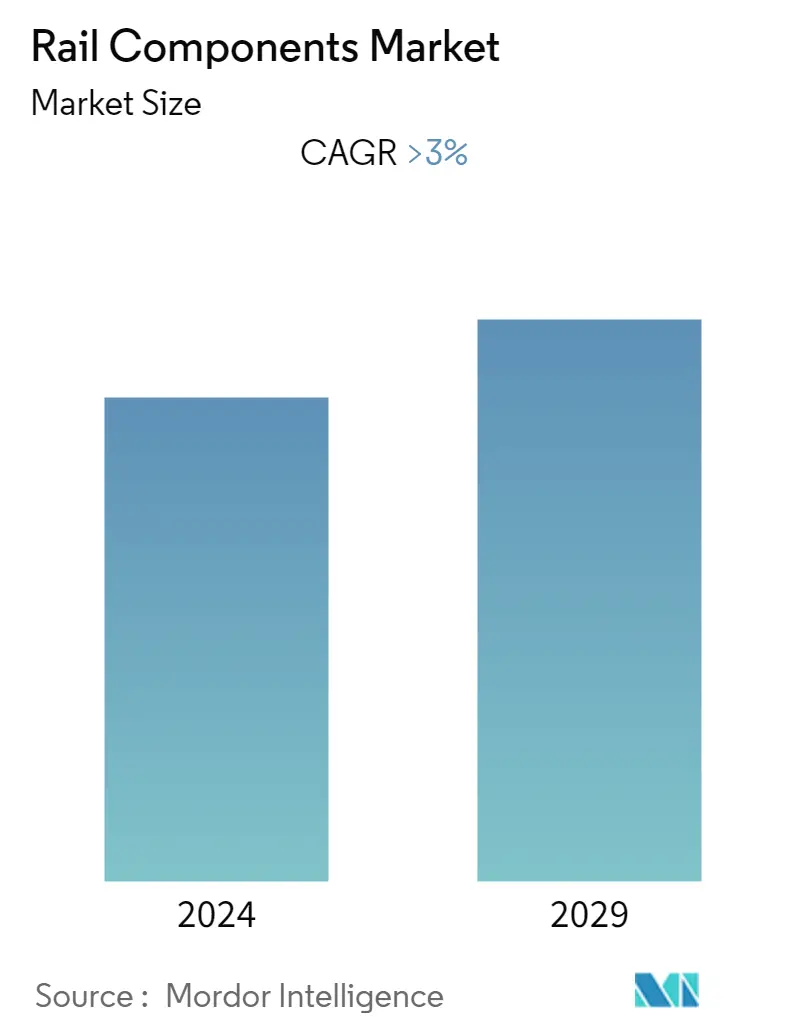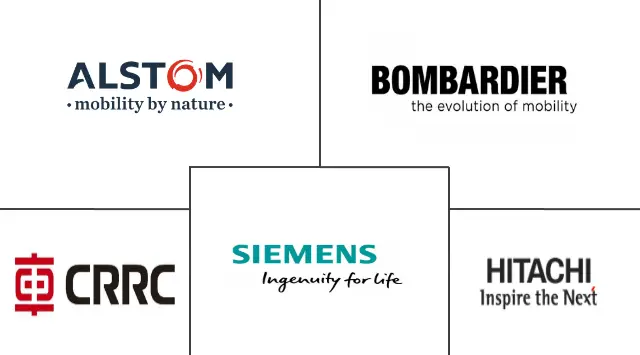Market Size of Rail Components Industry

| Study Period | 2019 - 2029 |
| Base Year For Estimation | 2023 |
| CAGR | > 3.00 % |
| Fastest Growing Market | Asia Pacific |
| Largest Market | North America |
| Market Concentration | High |
Major Players
*Disclaimer: Major Players sorted in no particular order |
Rail Components Market Analysis
The rail components market was valued at USD 78 billion in 2020, and it is expected to reach USD 95 billion by 2026, registering a CAGR of more than 3% during the forecast period (2021 - 2026).
The outbreak of COVID-19 acted as a massive restraint on the rail components market in 2020, as supply chains were disrupted due to trade restrictions and consumption declined due to lockdowns imposed by governments globally.
However, the market is expected to regain its growth post lockdown, as governments are going to introduce many new projects to maintain social distancing, as people will be more concerned about the safety and security and clean air in the bogies in the wake of the pandemic. These measures are likely to boost the production of new bogies and necessary rail components during the forecast period.
An increase in developments of metro projects and expansion of electrified network rail routes will further create opportunities for OEMs to expand their revenue stream and increase their geographical presence. Factors, such as the increase in investments in rail infrastructure and expansion of rail networks in densely populated regions, will enable the growth of the rail components market.
Asia-Pacific is expected to witness significant growth during the forecast period owing to the high demand for rail transportation from countries like China, Japan, South Korea, and India. Meanwhile, in Europe and North America, the market is anticipated to grow due to the rising demand for passenger and freight transportation.
Rail Components Industry Segmentation
Rail components majorly include railway tracks, railway sleepers, turnout, rail fastening systems, and railway fish plates. The Rail Components Market report covers the latest trends, covid-19 impact followed by technological developments in the market. The scope of the report covers segmentation based on Component type and Geography.
By Component type, the market is segmented into Bogie, Engine, and Others and by Geography type, the market is segmented into North America, Europe, Asia-Pacific and Rest of the world. For each segment, the market sizing and forecast have been done on basis of value (USD billion).
| By Component | ||||||
| ||||||
| Engine | ||||||
| Others ( Couplers, Body Frames, etc) |
| Geography | |||||||
| |||||||
| |||||||
| |||||||
|
Rail Components Market Size Summary
The rail components market is poised for growth, driven by increasing investments in rail infrastructure and the expansion of rail networks, particularly in densely populated regions. The market experienced a setback due to the COVID-19 pandemic, which disrupted supply chains and reduced consumption. However, the post-pandemic recovery is expected to be bolstered by government initiatives aimed at enhancing safety and air quality in rail transport. The development of metro projects and the expansion of electrified rail routes are creating new opportunities for original equipment manufacturers (OEMs) to broaden their revenue streams and geographical presence. The Asia-Pacific region, especially countries like China, Japan, South Korea, and India, is anticipated to witness significant growth due to the high demand for rail transportation. In Europe and North America, the market is also expected to grow, driven by the rising demand for both passenger and freight transportation.
The bogie segment is projected to hold a substantial share of the market, supported by the growing adoption of powered bogie designs worldwide. Innovations in bogie technology, such as those by Global Railway Engineering Pty Limited and Siemens, are enhancing safety and efficiency, with investments in research and development focusing on integrating IoT devices. Collaborative projects, like the CaFiBo project involving Alstom and Magma Structures, aim to reduce bogie mass and maintenance costs through lightweight composite materials. The market is consolidated, with major players like Siemens AG, Bombardier Inc., CRRC Corporation Limited, Alstom, and Hitachi engaging in strategic activities such as mergers, acquisitions, and collaborations to expand their product portfolios and enhance their market presence. These developments, along with initiatives like India's Make in India, are expected to drive the growth of the rail components market in the coming years.
Rail Components Market Size - Table of Contents
-
1. MARKET DYNAMICS
-
1.1 Market Drivers
-
1.2 Market Restraints
-
1.3 Industry Attractiveness - Porter's Five Force Analysis
-
1.3.1 Bargaining Power of Suppliers
-
1.3.2 Bargaining Power of Consumers
-
1.3.3 Threat of New Entrants
-
1.3.4 Threat of Substitute Products
-
1.3.5 Intensity of Competitive Rivalry
-
-
-
2. MARKET SEGMENTATION
-
2.1 By Component
-
2.1.1 Bogie
-
2.1.1.1 Brake System
-
2.1.1.2 Suspension System
-
2.1.1.3 Wheel and Axle
-
2.1.1.4 Other Bogies ( Gear Box, Motor, and Supporting Frames)
-
-
2.1.2 Engine
-
2.1.3 Others ( Couplers, Body Frames, etc)
-
-
2.2 Geography
-
2.2.1 North America
-
2.2.1.1 United States
-
2.2.1.2 Canada
-
2.2.1.3 Mexico
-
-
2.2.2 Europe
-
2.2.2.1 Germany
-
2.2.2.2 United Kingdom
-
2.2.2.3 France
-
2.2.2.4 Rest of Europe
-
-
2.2.3 Asia-Pacific
-
2.2.3.1 India
-
2.2.3.2 China
-
2.2.3.3 Japan
-
2.2.3.4 South Korea
-
2.2.3.5 Rest of Asia-Pacific
-
-
2.2.4 Rest of the World
-
2.2.4.1 Brazil
-
2.2.4.2 South Africa
-
2.2.4.3 Other Countries
-
-
-
Rail Components Market Size FAQs
What is the current Rail Components Market size?
The Rail Components Market is projected to register a CAGR of greater than 3% during the forecast period (2024-2029)
Who are the key players in Rail Components Market?
CRRC Corporation Limited, Siemens AG, Alstom SA, Bombardier Inc. and Hitachi Ltd are the major companies operating in the Rail Components Market.

